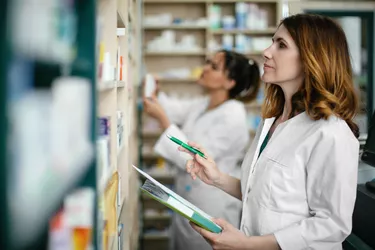
Pharmacy technicians and pharmacists often work next to each other in clinics, hospitals and pharmacies, but the licensing requirements for both jobs are vastly different. A pharmacy technician who has completed only the minimal educational requirements must finish six to seven years of school in order to become a fully licensed pharmacist. Often, coursework, final examinations and clinical experience obtained during the course of work as a pharmacy technician cannot be applied toward any state pharmacist licensing requirements.
Learn about how to become a pharmacist versus how to become a pharmacist tech and see how the prospects and earnings vary for each career.
Video of the Day
Video of the Day
Consider also: Five Most Important Aspects of a Job
Education for Becoming a Pharmacist
To become a pharmacist, a student must complete a course of study at a pharmacy school and obtain a Pharm.D. degree, which generally takes about four years. Some students complete two to four years of undergraduate study before entering a Pharm.D. program, although not all schools require this. Pharmacists interested in clinical work often complete a one or two-year fellowship after receiving their Pharm.D. degree.
Pharmacy technicians typically need only a high school diploma or its equivalency. They can receive on the job training to learn the job. Therefore, a pharmacy technician must complete all of the pharmacist educational requirements to become a pharmacist.
Consider also: The College Application Process
Pharmacist and Technician Examination Requirements
Pharmacists hoping to become licensed through their state pharmacy boards must also pass an examination, although specific examination requirements vary from state to state. The two main pharmacist licensing examinations in the United States are the North American Pharmacist Licensure Examination, or NAPLEX, and the Multistate Pharmacy Jurisprudence Examination, or MPJE. State pharmacist regulations often require one or both of these for licensure as a state pharmacist.
Only some states require pharmacy technicians to pass an exam for certification. In these cases, it will not satisfy the pharmacist exam requirement.
Experience Required for Pharmacists
In addition to classroom education and the licensing examination, a prospective pharmacist must also obtain a certain amount of clinical hours working as a pharmacist or an assistant. The exact amount of hours which a student must finish before becoming a state-licensed pharmacist varies from state to state but generally ranges from 1,200 hours to 2,000 hours.
Some states do require clinical experience before licensing a pharmacy technician, but again, this will not satisfy the requirement for pharmacists so a pharmacy technician must start the process from scratch.
Pharmacist Versus Pharmacy Tech Outlook
The Bureau of Labor Statistics expects a better job outlook for pharmacy technicians than it does for pharmacists. Jobs for pharmacy technicians were expected to increase by four percent between 2020 and 2030. In comparison, pharmacist job opportunities were expected to decline at a two percent rate during the same period. Pharmacist jobs will be affected by mail-order options, while pharmacy techs can expect an expanding role with additional duties.
Competition will be a little more difficult than it is for pharmacist job openings because of the relatively easier educational path for pharmacy technicians. Becoming a pharmacist who works at a healthcare facility can lead to better prospects.
When considering how many years to become a pharmacist, you'll find the many years of training leads to much better earnings potential. The BLS median salaries as of May 2021 were $128,570 for pharmacists and a much lower $36,740 for pharmacist technicians.
Consider also: How's the Job Market Now for New College Grads?